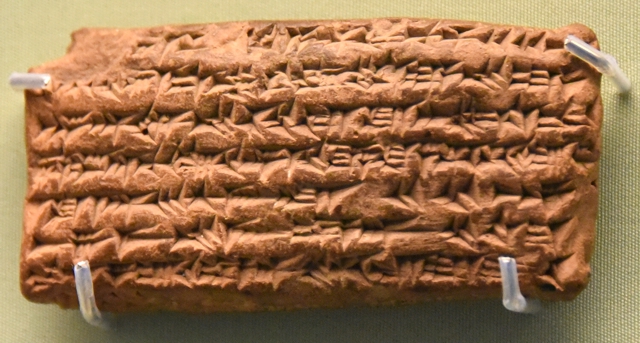
| SHAGARAKTI-SHURIASH
The Nabonidus Cylinder which names Šagarakti-Šuriaš as builder of the Eulmaš temple
Reign : 1245 - 1233 BC
Preceded by : Kudur-Enlil I
Succeeded by : Kashtiliash IV / Kaštiliašu IV
Regnal titles of Shagarakti-Shuriash : King of Babylon
Shagarakti-Shuriash / Šagarakti-Šuriaš, written phonetically ša-ga-ra-ak-ti-šur-ia-aš or dša-garak-ti-šu-ri-ia-aš in cuneiform or in a variety of other forms, Šuriaš (a Kassite sun god corresponding to Babylonian Šamaš) gives me life, (1245–1233 BC short chronology) was the twenty seventh king of the Third or Kassite dynasty of Babylon. The earliest extant economic text is dated to the 5th day of Nisan in his accession year, corresponding to his predecessor’s year 9, suggesting the succession occurred very early in the year as this month was the first in the Babylonian calendar. He ruled for thirteen years and was succeeded by his son, Kaštiliašu IV.
Biography
:
Economic
turbulence :
It has been suggested that the preponderance of commercial texts detailing debts, loans and slave transactions indicate that Babylonia faced hard economic times during his reign, where people sold themselves into slavery to repay their creditors. One of which seems to indicate his involvement in the incarceration of an individual while another is a declaration of zakût nippureti, "freeing of the women of Nippur" as part of a general amnesty. Ini-Tešub, the king of Kargamiš, wrote a letter to him complaining about the activities of the Ahlamu and their effect on communications and presumably trade.
The
Sippar-Annunitu Eulmaš of Ištar-Annunitu :
-
Inscription of Nabonidus, cylinder BM 91124, in the British Museum.
Šhagarakti-šuriaš, a faithful shepherd, a revered prince, favorite of Šamaš and Anunit - am I. When Šamaš and Anunit, for lordship of the Land mentioned a name, they filled my hands with the leading string of all peoples. At that time Ebarra the temple of Šamaš of Sippar, my lord, and Eulmaš temple of Anunit of Sippar-Anunit, my lady, whose walls since the time of Zabum because of old age had sagged - their walls I demolished. Of their ruined foundations - I took away their earth. Their shrine(s) I preserved. Their plans I retained perfect. I filled in their foundations with earth; the supporting wall(s) I restored. Their walls in their places I embellished. Their appearance I rendered more excellent than before. Forever, O Šamaš and Anunit, because of my precious deeds may your hearts be glad. May they lengthen my days. May they renew (my) life. Days of joy, month(s) of happiness, years of prosperity may they grant (me) as a gift. A judgment of precision and justice may I speak, and may they cause peace to be always.
-
Inscription of Nabonidus, cylinder BM 104738, column III, lines
44 to 62.
Cuneiform inscriptions found on the lapis lazuli cylinder seal of Shagarakti-Shuriash were recorded on this clay tablet from Nineveh, Iraq. Circa 689 BC. Currently housed in the British Museum in London A clay tablet from the time of Sennacherib (705–681 BC) quotes a legendary inscription from a lapis lazuli seal. Originally the seal was in the possession of Shagarakti-Shuriash, but was carried off to Nineveh by Tukulti-Ninurta I (1243–1207 BC) as war booty when he sacked Babylon during Kaštiliašu’s reign, and he had his own inscription engraved on it without erasing the original. Sometime afterwards the seal again found its way back to Babylon, in circumstances unknown, where it was re-plundered, some six hundred years later by Sennacherib.
A brick discovered in situ in Nippur has an inscription along its edge which shows that Šagarakti-Šuriaš commissioned work here on the Ekur of Enlil as well.
Source :
https://en.wikipedia.org/ |

